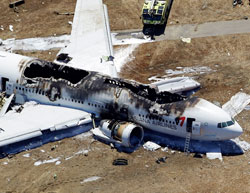FALL 2013 CONTENTS
Home
Hello in there
Seeing the fetus as a patient
Gone too soon
What's behind the high U.S. infant mortality rate
The children's defender
A conversation with Marian Wright Edelman
Too deeply attached
The rise of placenta accreta
Labor day
The c-section comes under review
Changing expectations
New hope for high-risk births
Inside information
What parents may – or may not – want to know about their developing fetus

DOWNLOAD PRINTABLE
ISSUE (PDF)


This is not a testIn airplane crash response, training and teamwork prevailed
“Did you know there’s been a plane crash at San Francisco airport?”
It was a little past 11:30 a.m. on July 6 when Eric A. Weiss, MD, the medical director of emergency management for Stanford and Lucile Packard Children’s hospitals, learned of the crash landing of Asiana flight 214. A television in the emergency department waiting room had reported the news, which made its way to Bernard Dannenberg, MD, the director of pediatric emergency medicine, and then to Weiss, both of whom, fortuitously, were working that day.
AP photo / Marcio Jose Sanchez

Weiss knew that if there were casualties, Stanford — one of only two level-1 trauma centers within 25 miles of the airport, and the only one with a helicopter-landing pad — would be well equipped to treat them. He had a committed, well-drilled staff, and many key emergency responders were already on site.
He also had good luck. Just three weeks before the crash, the ED had drilled the “code triage” response: exactly what they were about to face.
At 11:50 a.m. Weiss got the call he was waiting for. It was San Mateo County Emergency Services asking for a count of available beds.
“We can take as many as you need,” Weiss said. At 12:05 p.m., he paged about 800 staff with a “code triage-standby” message, indicating an extraordinary situation that might call for additional manpower and supplies.
He also dialed his partner in disaster response, Brandon Bond, administrative director of the office of emergency management for the two hospitals. As Bond arrived, a helicopter approached with two patients in critical condition, and an ambulance was coming with four more. A few minutes later, 12:47 p.m., Weiss activated the disaster plan with the code “triage-major.”
“This told everyone ‘all hands on deck, expecting major casualties, open the command center, clear out the emergency department and deploy the caches of disaster equipment that had already been pulled out and pre-staged,’” Bond says.
Within 30 minutes they had mobilized over 150 health-care providers and had set up a mass triage area in the emergency department parking lot and another area for less urgent casualties. Activated staff included physicians, nurses, technicians, clerks, registration personnel, transporters, social workers and translators.
David Spain, MD, chief of trauma and critical care surgery, was on site when patients began arriving by helicopter, ambulance and bus. The most common injuries were spine and rib fractures. Some were serious, a few requiring surgery, he says.
Most of the flight’s 307 passengers and crew were Korean or Chinese citizens. By the end of the day, close to 200 had been cared for at nine Bay Area hospitals. Ultimately three girls died of crash-related injuries. Fifty-five, including 16 minors, were evaluated at Stanford; 11 were admitted to Stanford and seven to Packard Children’s.
“As often happens in a crisis, many individuals stepped up and worked tirelessly to provide the best possible medical and social care to patients,” says Lloyd Minor, MD, dean of the School of Medicine. “But it was more than a willingness to help that was on display; it was the work of professionals trained to respond in an emergency situation.”
— Rosanne Spector


